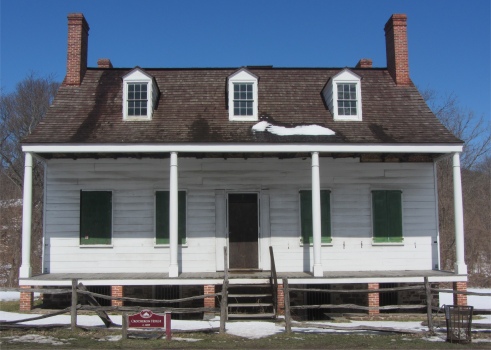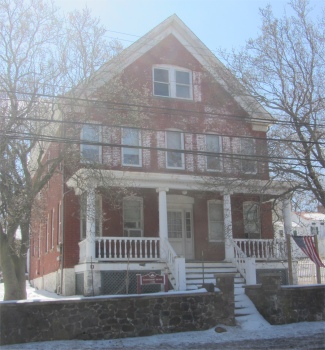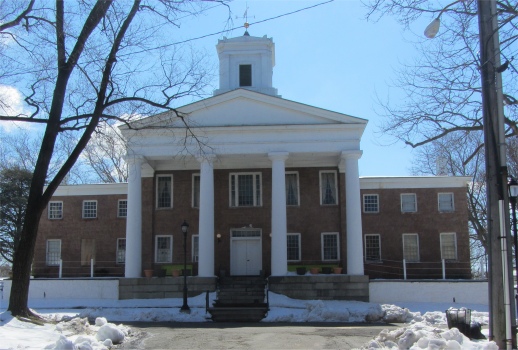
Third County Courthouse, 1837
|
Heading up from Richmond Road along a side road, Court Place, I was brought to an abrupt halt at its head on Center Street by the Third County Courthouse. It was built in 1837 on this site, replacing earlier courthouse buildings that had been located on other sites nearby.
Standing on one of the highest points in Richmond, this imposing Greek revival building was designed to both reflect and inspire civic power and pride. The front (north) wall of the structure is built of rough-faced Staten Island trap rock; the other walls are brick. The architectural form is a centre block with a pedimented portico and flanking wings. The portico is supported by four massive Doric columns.
By the 1830s, the population of Richmond County had grown to over 7,000 residents, and community leaders decided that the county needed a new and impressive courthouse to replace the smaller wood-frame structure in use at the time. The land on which the Courthouse was built was given to the county by Henry I. Seaman. In 1836 Seaman purchased a large piece of property between Richmond Road and Clarke Avenue with the intent of developing and enlarging the village of Richmond. He subdivided the land into 119 lots and built five cottages, and in April 1837 he transferred a large plot on Center Street to the county for the sum of $1 on condition that a new courthouse was to be constructed on the site "without reasonable delay."
In 1898, Staten Island became one of the five boroughs of New York City, and all local government and court functions were gradually moved to new facilities at St. George. The last court session held upstairs in the courtroom was in 1919. The Courthouse remained vacant from 1919 to 1932. Today the building serves as Historic Richmond Town's Visitor Centre and Museum Store.

Colon Store (Tinsmith's Shop), ca 1840-50, with Seaman Cottage Immediately Behind on Center Street
|
Walking a short distance east along Center Street I stumbled across Colon Store, also known as the Tinsmith's Shop. Built ca. 1840-1850, the store originally stood on Woodrow Road in Woodrow. It was moved to Historic Richmond Town in 1969.
The Colon Store is a two-story wood frame building with clapboard siding and a small front porch. Its unusual trapezoidal plan reflects the shape of its original building lot. This is a very simple rural structure built for commercial purposes. It has Greek revival moulding around the bottom panels of the front doors.
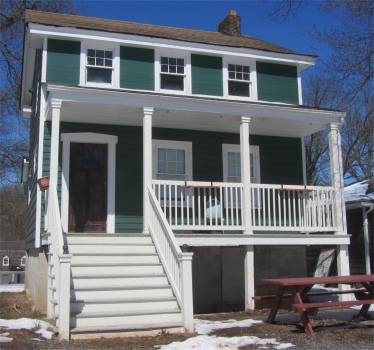
Sieman Cottage, ca 1836
|
The original owner was Mary Ann Winant (1808-1896), a widow who in 1859 married James Colon Jr. (1807-1898), a chair maker and carpenter. They were proprietors of the store probably until the 1890s. New York City gave the building to the Staten Island Historical Society, and it was moved to Historic Richmond Town in 1969. Restoration of the building was completed in 1971, and it has been interpreted as a tinsmith's shop since 1978.
Next along past the Tinsmith's Shop was Seaman Cottage built ca. 1836-1837 by developer Henry I. Seaman. It is a good example of a modest Greek revival building. The term "cottage" was used in the 19th century to describe a small, modern, up-to-date house that was suitable for middle-class occupants. It is a small two and one-half story gable roof structure resting on a newly constructed masonry basement and has a one story wood porch extending across its front.
Henry I. Seaman (1805-1861) was a New York City businessman who was a descendant of the prominent Billopp and Seaman families of Staten Island. In addition to his business activities, Seaman was a leader in the Whig political party on the Island and was elected to Congress as the Representative for Richmond and Kings Counties in 1846. He was also a director of the Staten Island Railroad (founded 1851) and private secretary to Governor John Alsop King (1856-1857).
In 1836, Seaman devised an ambitious development scheme that more than doubled the size of the village of Richmond. He purchased 90 acres of farmland between Richmond Road and Clarke Avenue. He had the land laid out into two new streets, Center Street and Court Place, and 119 building lots. Over the course of time he sold lots and built houses on the site.

Historical Museum, 1848
|
Heading in the opposite direction along Center Street I came across the Historical Museum. It is a large brick structure in its original location on Center Street at the corner of Court Place. Its architecture features decorative bracketed eaves of the Italianate style. It was at one time stuccoed and incised in imitation of brownstone blocks, a finish which was removed in the 1930s.
It was originally constructed in 1848 as a one-story building to house the County Clerk's and Surrogate's offices, which were previously located across the street in the Third County Courthouse. The building also housed the offices of the County Board of Supervisors and the District Attorney. Due to the offices outgrowing the building, it had a series of additions made to it until in 1920, the building was abandoned as government offices moved north to St. George.
Inside the museum I encountered a rotund, elderly chap who was the museum's curator. "Hi, do you mind if I look around your museum? Oh, I understand there is a guided tour at 1pm, can I sign up for it please?" I asked.
"Sure, but the tour won't start until 2pm. That will be 8$," replied the man. On realising I was English, the fellow piped up, "I was in Ireland a few years ago."
Really, are your roots there?" I enquired.
"No, I'm a Viking. My ancestors came from Denmark. My surname is Hansen," he boasted.
"Most of the Danish surnames are Hansen," I laughed. I took a stroll around the museum. Its tale, told through display boards, photos, ancestral records, artefacts and press cuttings, exposed a completely authentic, real and original town complex featuring unique treasures dating all the way back to the mid-1600s.

"Staten Island" or "Yankee" Skiff, c. 1890
|
Despite developments in commerce, real estate, and industry, Staten Island retained much of its rural character throughout the 19th century. Well past the Civil War, large numbers of island residents continued to make their livelihood and take their sustenance from the area's two most obvious resources: the land and the surrounding sea. In 1840 one-sixth of the island's male population was engaged in agriculture; nearly as many were occupied in maritime pursuits such as fishing and shellfish cultivation. Staten Island later became involved in textile dyeing, silk printing, carriage manufacturing and brewing.
A chap, Joe, turned up to act as tour guide, a middle aged fellow, in ultra-casual attire, sporting a shrub land of stubble, and a voice betraying his Italian extract. We were joined by a fellow with three kids: a girl aged around 8 years old, and her two brothers aged roughly 6 and 4 years old. The kids were fairly well behaved to start with, but the boys proved a bit of a challenge for the guide and the father, who later informed me he had left a fourth one at home.

New Dorp Railroad Station, 1889
|
Joe gave a short spiel about the Richmond Settlement and how the Dutch had been the prime movers and shakers. It was indeed a short spiel, and soon we headed down Center Street, passing a diner which had once been used in a film set. This structure was constructed for location filming of the television series
Boardwalk Empire. It represents a 1920s American diner in the fictional town of Tabor Heights, New Jersey. This set was utilized for episodes which originally aired during the show's third season, in the fall of 2012. Once it had served its purpose, the film makers just abandoned it.
Just past this interloper lay New Dorp Railroad Station. This railroad station, which once served the neighbourhood of New Dorp, was built in 1889 and moved to Historic Richmond Town in 1965. It is a structure with a single rectangular room. The roof once had large eaves creating a porch around the building which served as the waiting platform; these features were removed for the process of relocating the structure and have not yet been restored. The architecture shows elements of the Queen Anne style and the stick style. Picturesque details include applied wood boards and brackets, double doors, and windows with sash holding multi-coloured glass.
New Dorp was settled about 1671. Early settlers were Dutch, French, and English who made their living through farming and fishing. William H. Vanderbilt played a role in the establishment of a railroad line in the 1860s that ran through the area, and suburban real estate development began soon after, with a cluster of commercial establishments around the railroad station that continues to this day. The railroad also facilitated the growth of seaside amusement areas and resorts nearby.
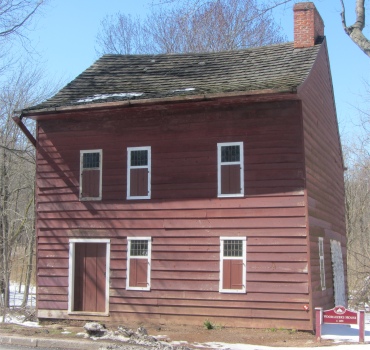
Voorlezer's House, ca. 1695
|
At the bottom of Center Street lay the busy Arthur Kill Road. Joe earned his crust by acting as a lollipop man without the lollipop, and held up the traffic while we crossed the road. I teased him about his missing lolly, but he had no idea what I was talking about.
What attracted us to the other side was Voorlezer's House. Constructed ca. 1695, it is an example of Dutch-influenced vernacular architecture, but is atypical and an unusually large structure for its early period. Archaeological findings, reported in 1985, produced artefacts dating as early as 1740.
Built by the Dutch Reformed congregation as a religious facility, it also contained the residence of the congregation's Voorlezer, Hendrick Kroesen, and his family from ca. 1695 until 1701. The Voorlezer's typical function within the church involved reading the Bible aloud, keeping church records, performing rites such as baptism, and educating children. Sermons would be presented by a visiting Domine (minister), who was likely received as a guest in the Kroesen's living area. The size of the congregation may have been about 82 adults, and 25-30 potential students, at a time when the entire island held about 700 residents. Records were kept in the Dutch language, and it is assumed that both Dutch and English were spoken here.
Beginning in the 1880s, the building contained a residence and store operated by Solomon Rosenberg, a dry goods merchant, and his family. By the 1890s, the Rosenbergs' hotel-saloon on the premises was known as the Arlington Hotel, and around 1910 a sign identified it as the Richmond Road House. The family's business included retail liquor sale, which may have ended with passage of the 18th Amendment in 1920. Presumably "near beer" was sold during the era of Prohibition. From 1924 to about 1936, the establishment was operated by Nicholas George under the name of Acorn Inn, while the building was owned by Marie Peterson.

Boehm House, ca 1750
|
Next to Voorlezer's House stood Boehm House, typical of Staten Island farmhouses of the 18th and 19th centuries. It shows Dutch influence in the older (southern) portion of the house. It was moved to Historic Richmond Town in 1965.
Based on its architectural fabric, the house is thought to have been constructed ca. 1750, but the original owner/occupant of the house is not known. The first recorded occupant was Cornelius Poillon, who mortgaged the property in 1814. Three other property owners are recorded between 1819 and 1855, when educator Henry Martin Boehm purchased the house.
Boehm (1819-1862) was a teacher and a Staten Island school commissioner. He and his wife Rizpah resided in the house and also used the house as a school. When Boehm died in 1862, the house was willed to his wife. The 1865 census shows Rizpah living in the house with family members and boarders from Cuba and Central America. Around 1870, Boehm's father, Henry Boehm, moved into the house with Rizpah. Henry Boehm was a noted Methodist minister who preached in Pennsylvania and New Jersey before coming to Staten Island around 1835, and he remained in the house until his death at the age of 100, in 1875.
Rizpah remained in the house until her passing in 1898, and the house became the property of their daughter, Mary Boehm Fuentes. Mary was also an educator. She specialized in teaching English to Spanish-speakers, and census records indicate that students and boarders from Spain, Cuba, and Puerto Rico also resided in the house at various times. Mary continued to teach until 1927, when she was 85 years old. She sold the house in 1933.
The ground floor which we sat in was furnished as an old classroom; quite appropriate considering it's usage over the years. This held some fascination for the eldest two kids. Joe then produced a "plonk", a sort of round wooden paddle on the end of a stick which would have been used for administering punishment in class. The boys were not at all perturbed by this and their confidence levels had stretched to disobedient mode, much to Joe's disappointment and the father's embarrassment. Joe proclaimed it as the oldest standing single room school in America. Upstairs was still empty, with a lot of timbers exposed, giving an excellent insight to how the building was constructed.
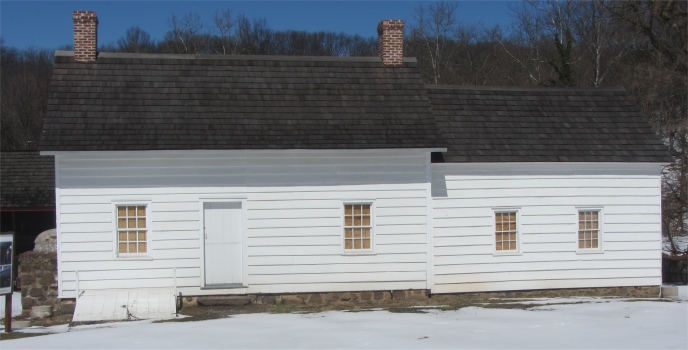
Kruser-Finley House, ca. 1790
|
Joe displayed his well-trained lollipop skills once again by getting us across the Richmond Road. A stroll over the still crisp virgin snow brought us to the delightful looking Kruser-Finley House. It was moved to Historic Richmond Town in 1965.
The building is a clapboard residence with a fieldstone foundation and an unfinished basement. It is composed of two sections; the newer, eastern section is lower in height and is sided with shingles. It was built ca. 1790, with additions ca. 1820 and ca. 1840-1890.
The building was probably part of a small tenant farm originally, and became home to Abraham Kruser's family of four about 1841. It is thought that it may have served as a multi-purpose farm workshop. His son, Frederick, may have used it for building barrels. In 1874 the property was sold to Patrick Finley, whose son, James, took up residence with his family. The Finley family occupied the house from 1874 or 1875 to 1946, giving them the longest tenure of any family associated with the structure. The Finleys were part of a community of Irish immigrants, having left Ireland during the peak years of the potato famine. Joe explained how a group of vandals had tossed some lit matches into the roof causing severe fire damage in August 2013; restoration was completed in 2015.
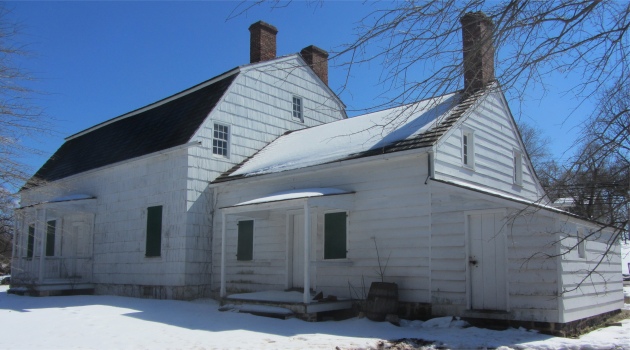
Rear of Guyon-Lake-Tysen House, ca 1740
|
I asked our guide about the security arrangements for such an exposed collection of historic buildings, sitting on the main Richmond Road. Apparently the land belonged to New York City, but the buildings were the responsibility of the Staten Island Historic Trust. In a nutshell, if the houses go to rack or ruin New York City does not pick up the tab. "The governor of the site, if you can define the governor, cut back on money for security. You save the money but take the risk," explained Joe.
Just up the road stood the Guyon-Lake-Tysen House. It was moved to Historic Richmond Town in 1962. It is unusually large by 18th-century Staten Island standards and represents a substantial, prosperous way of life. It was constructed as a farmhouse and was used as such for most of its history. It was situated in an area of large, fertile farm plots of substantial acreage.
The house is one of few 18th-century gambrel-roof houses surviving on Staten Island today. This once-common form combines Dutch and Franco-Flemish features in a style that was later dubbed "Dutch Colonial." It is exceptional for the survival of its interior wood panelling and detailing. It has two stories plus a cellar and attic, and a kitchen extension to the west. The main portion of the house has dormers and a wide front porch. The kitchen has a wide spring eave on the front, a small porch at the back door, and a small woodshed attached to the west end.
Joseph Guyon, a farmer of Huguenot descent, constructed the house ca. 1740 (his name can still be seen written in the clay daubing above the door of the middle parlour), but he only finished part of the interior. Joseph was a bachelor, and when he died in 1758 the house and property were willed to his eight-year-old nephew, also named Joseph Guyon.
In 1812, the house and property were sold to Daniel W. Lake, a farmer of English descent. He increased the land holdings to 115 acres and added the two-story kitchen wing ca.1820, replacing an older structure. Daniel Lake died in 1839, and some of the land was sold, but the house and land adjacent stayed with Lake's daughter Elizabeth and her husband David J. Tysen. In 1840 they had four children and Elizabeth was 26. In all, she bore 14 children, ten of whom lived to adulthood. While they lived in the house they completed the upstairs bedrooms, added three dormer windows, and changed the staircase.
Joe took pains to point out that the house had obviously belonged to wealthy individuals in its history; no expense had been spared. Downstairs there were fireplaces in every room, and even a separate brick oven in the kitchen, which itself was well adorned. In fact the building is often hired out for functions where the occupants cook over the open fireplace or in the oven, and they can also sleep over. This house was indeed exceptional, it had multiple parlours. The quantity of large windows added to the light and airy feel to the house. Sadly, quite a few were boarded up due to vandalism.

Interior of the Guyon-Lake-Tysen House
|
Our final port of call with Joe was the General Store, located at its original site on Court Place, and is attached to the rear of the Stephens-Black House. It is a rectangular structure of one story with an attic. It was constructed in stages beginning ca. 1840, but most of the structure was demolished in the 1940s. It was restored and reconstructed by Historic Richmond Town in 1964.

General Store, ca. 1840
|
The store was built as part of the Stephens-Black House, the home of merchant Stephen Dover Stephens (1808-1883), his wife Elizabeth Johnson Stephens (1811-1883), and their five children. The main part of the house was built ca. 1838, and the first section of the store wing was added to the rear of the house ca. 1840. The store was subsequently expanded three more times prior to 1874.
The store was a popular gathering spot. The village of Richmond was a bustling place, particularly on trial days, and the store was a place for neighbours to meet and catch up on the news of the day. It also served as the village post office. Stephens offered a wide variety of goods for purchase, including flour ground at nearby Geib's Mill, spices, muslin and ribbon, household goods, nails, and turpentine.
In 1870, the Stephens family sold the house and store to Mary Black, who moved to Staten Island from Manhattan with her husband Joseph and their family. The Blacks had twelve children living with them in 1870; they also had one domestic servant and one worker in the store. Their oldest son, James, probably headed the store for a time during the 1870s, before possibly departing Staten Island. Parents Mary and Joseph Black both died around 1876. Their eldest daughter, Victorine, married and left the household, while her sisters Josephine, Sarah, and Mary Black successfully operated the store and post office from around 1880 to 1920.They were remembered by a contemporary as "delightful ladies who knew all the town news and gossip: past, present and future. They were enabled, since they possessed the only public phone in the vicinity, to garner much information concerning local private lives. For all their inquisitiveness, these ladies were kind to small girls who came in to do errands and nothing was said if we helped ourselves from the cracker barrel or took a handful of brown sugar from the bin or a few prunes from the prune box."
During the many years that they ran the store, the sisters saw great changes in the store and in their community. As America moved from a predominantly rural society to a more urbanized one, factory-made products replaced ones made at home and national brands outsold local goods. Customers began to rely more heavily on retail catalogues and to travel to Manhattan to do their shopping. These trends spelled the eventual downfall of the general store.
In 1926, Sarah, the last Black sister, sold the house and store to Bertha and Willett Leslie Conner. The Conners were descended from prominent early families of Staten Island and were parents of 16 children. Willett's businesses included real estate and he also served as postmaster. After Willett Conner's death in 1932, Bertha Conner continued to operate the post office in the store wing. By 1944, the store was so dilapidated that all but part of the first section was torn down, and two years later Mrs. Conner sold the house. The demolished sections of the store were reconstructed by Historic Richmond Town in 1964 with funding from Marjorie Wells Proctor in memory of Elizabeth Stephens Wells, granddaughter of the original owner.
Today the contents of the store were a complete treasure trove, the kids bewildered as to what most of it was - they were a picture.
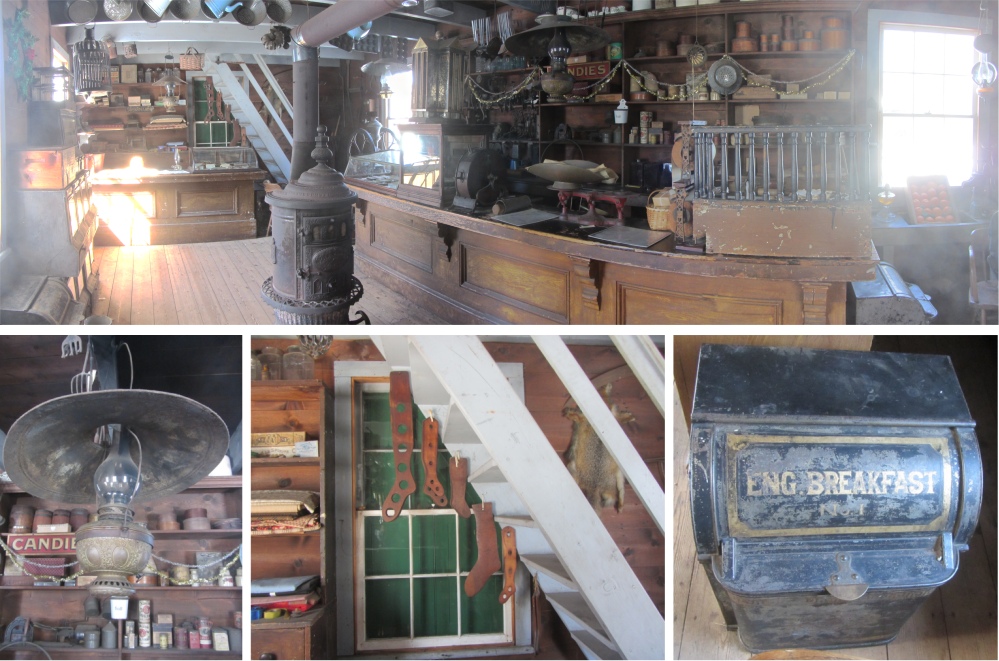
Interior of the General Store
|
We were done and went our separate ways, the kids whinging that they were hungry, bless their cotton socks. There were too many other buildings within the town to cover here, but I hope I have given a flavour for what this delightful site has to offer.
I headed back to Manhattan. Bored U.S. Coastguard boats played cat and mouse with the ferries that plied back and forth. Large containerships slid by on their way to the open sea. This harbour never slept.
Back in the Big Apple, I made my way to Greenwich Village while it was still light. After a bite to eat I came across Arthur's Tavern advertising live jazz and blues music. I discovered it was opened in 1937, and is an internationally recognized nightclub located for more than 60 years in a designated historic building in the heart of New York City's exciting Greenwich Village. Arthur's hosts outstanding live jazz, blues, rhythm & blues, and Dixieland jazz music every night of the week. Called the "Home of the Bird," this historic entertainment nightclub is the last continuously operating New York City jazz club, once regular host to the legendary Charlie Parker and the great Roy Hargrove.
I ventured inside to find a dark, cramped interior that betrayed its long history, the smoke now removed. Four guys sat around a table, and a young couple were standing at the bar in a passionate embrace. A few really old fellows were on a stage at the far end of the bar, sporadically warming their fingers and instruments up. I ordered a beer, and asked the girl behind the bar, "Can I sit at the small table next to the stage?" She shrugged her shoulders and uttered something which I took to mean yes. A couple more octogenarians rolled in up to the stage, and without any warning the jazz band started up. Despite their age, the elderly gang knew how to play jazz. It was not long before the passionate couple left, and more customers joined the bar crowd.
The band looked tired, as if they had done this routine for thousands of years, and I thought I detected a little tension between some of the wind instrumentalists, but I eventually put this down to them being cantankerous old men. They played flawlessly, covering perfectly when any one of them dropped out for a comfort break. Midway through one tune, the trombone player got up, walked to the bar, took three glasses off a shelf, put ice in them, and the bar lady topped them up with Bourbon. He returned to continue playing, with a glass each for the wind instrumentalists. Between songs they would casually chat between themselves about which number they would perform next, and the key they would play it in, before the trumpet "leader" spun a few words out to provide continuity to the listeners.
An elderly lady walked into the bar wearing a white chiffon top, and sprouting pig-tails, the ones that stick out horizontally from the ears, identical to the way my granddaughter's stick out at times, bound up in white and pink material. The effect was to me a little odd for a woman her age, but this is New York after all. Later, during the evening, the trumpet player introduced her, and she reluctantly but at the same time with great gusto, got up and sang beautifully. The bar was by now packed, the band tip bucket was filling up rapidly (there was no cover charge in Arthur's Tavern, but the drinks were a tad expensive), and the applause very enthusiastic.
After the band, The Creole Cooking Jazz Band, wound up with its signature song, Duke Ellington's
"Creole Love Call", the trombone player, who had asked me for requests earlier (but my tastes were far more recent than what they were playing), came over for a chat. The music they tended to play was characteristic of New Orleans in the first quarter of the 20th century. "Have you been playing together for some time, or are most of you session men?" I asked.
"We all go back some time," the man answered. "We all used to play at college, not together, but as time went by we all met up and started playing together. We've known each other for a long time now, in fact we've been playing here for 26 years. The band plays here every Sunday for the love of music, not money. Where are you from?" he asked.
"England."
"I know that, but whereabouts?"
"East Anglia."
"Oh, I know that area, it was important during the war. I was fortunate, I was born just after the war," he declared.
"You're still quite young," I smiled, hoping to make his day.
"Thank you, you're very kind. The next band coming on plays a totally different kind of music, more soul than anything else. It's not my taste. But they've been here for about 8 years now, so they are not a fly-by-night group." He was now off home for a drink. We shook hands, and off he headed out into the cold, dark night. He was going to drive home, with quite a few Bourbons inside him for company.
The crowd in the bar was turning over during the interval between the two bands, more younger folk were settling in. Three young women and a guy sat down at the table next to me. One of the women had one of those shrieking "listen to me, listen to me!" type of voices. She was engaged in one way traffic conversation to the girl sitting opposite her. The chap and the girl opposite him sat in silence, but I could tell by the body-language that they were jarred off with motor mouth.
The second band were soon up and running, starting off with their tribute version of
"Memphis, Tennessee" to Chuck Berry who had passed away the previous day. Then they effortlessly glided into their own stuff. Stew Cutler and His Friends blasted out an eclectic mixture of jazz, soul, blues, funk, roots, rhythm & blues. I was completely impressed at Cutler's ability with the guitar, his fingers moving effortlessly up and down the frets at lightning speed. This one time session man had become a composer, arranger, and leader to showcase his unique style and musical voice comparisons; pure musical expression delivered with honesty and integrity, total talent.
Meanwhile, two of the girls at the adjacent table got up and danced, which seemed to please the guitarist. The other two at the table were reluctantly dragged up, and soon the bar was singing
Happy Birthday to motor mouth. A very able singer joined the band on stage, with the gift of getting everybody up and jiggling about.
I would have loved to stay there longer, but it was quite late, I was getting tired, and I had consumed quite a few beers in the giddy atmosphere. I left after slipping some notes into the band's tip box, and made the slow journey back to base. At this late hour, trains were less frequent, but they ran all night. I didn't feel any apprehension travelling alone at this time of night, totally different to 30 years earlier. New York City had certainly cleaned up its act since I was last here.
